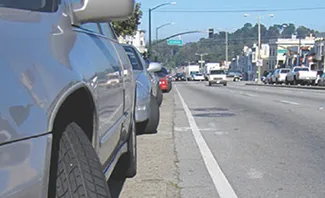![]()
Street Design Elements
33 Lane Width
37 Sidewalks
38 Sidewalk Zones
40 Sidewalk Design
45 Curb Extensions
47 Gateway
48 Pinchpoint
49 Chicane
50 Bus Bulbs
51 Vertical Speed Control Elements
53 Speed Hump
54 Speed Table
55 Speed Cushion
57 Transit Streets
58 Dedicated Curbside/ Offset Bus Lanes
60 Dedicated Median Bus Lanes
61 Contra-Flow Bus Lanes
62 Bus Stops
65 Stormwater Management
67 Bioswales
68 Flow-Through Planters
69 Pervious Strips
70 Pervious Pavement
The elements that make up city streets, from sidewalks to travel lanes to transit stops, all vie for space within a limited right-of-way. Transportation planners and engineers can use this toolbox to optimize the benefits the community receives from its streets.
![]()
Lane Width
The width allocated to lanes for motorists, buses, trucks, bikes, and parked cars is a sensitive and crucial aspect of street design. Lane widths should be considered within the assemblage of a given street delineating space to serve all needs, including travel lanes, safety islands, bike lanes, and sidewalks. Each lane width discussion should be informed by an understanding of the goals for traffic calming as well as making adequate space for larger vehicles, such as trucks and buses.
Travel lanes are striped to define the intended path of travel for vehicles along a corridor. Historically, wider travel lanes (11–13 feet) have been favored to create a more forgiving buffer to drivers, especially in high-speed environments where narrow lanes may feel uncomfortable or increase potential for side-swipe collisions.
Lane widths less than 12 feet have also historically been assumed to decrease traffic flow and capacity, a claim new research refutes.1
DISCUSSION
The relationship between lane widths and vehicle speed is complicated by many factors, including time of day, the amount of traffic present, and even the age of the driver. Narrower streets help promote slower driving speeds. which in turn reduce the severity of crashes. Narrower streets have other benefits as well, including reduced crossing distances, shorter signal cycles, less stormwater, and less construction material to build.
Lane widths of 10 feet are appropriate in urban areas and have a positive impact on a street’s safety without impacting traffic operations. For designated truck or transit routes, one travel lane of 11 feet may be used in each direction. In select cases, narrower travel lanes (9–9.5 feet) can be effective as through lanes in conjunction with a turn lane.2
RECOMMENDED
Lanes greater than 11 feet should not be used as they may cause unintended speeding and assume valuable right-of -way at the expense of other modes.
Restrictive policies that favor the use of wider travel lanes have no place in constrained urban settings, where every foot counts. Research has shown that narrower lane widths can effectively manage speeds without decreasing safety and that wider lanes do not correlate to safer streets.3 Moreover, wider travel lanes also increase exposure and crossing distance for pedestrians at intersections and midblock crossings.4
Use striping to channelize traffic, demarcate the road for other uses, and minimize lane width.
SAN FRANCISCO, CA
Striping should be used to delineate parking and curbside uses from the travel lane.
Lane width should be considered within the overall assemblage of the street. Travel lane widths of 10 feet generally provide adequate safety in urban settings while discouraging speeding. Cities may choose to use 11-foot lanes on designated truck and bus routes (one 11-foot lane per direction) or adjacent to lanes in the opposing direction.
Additional lane width may also be necessary for receiving lanes at turning locations with tight curves, as vehicles take up more horizontal space at a curve than a straightaway.
Wide lanes and offsets to medians are not required but may be beneficial and necessary from a safety point of view.
OPTIONAL
Parking lane widths of 7–9 feet are generally recommended. Cities are encouraged to demarcate the parking lane to indicate to drivers how close they are to parked cars. In certain cases, especially where loading and double parking are present, wide parking lanes (up to 15 feet) may be used. Wide parking lanes can serve multiple functions, including as industrial loading zones or as an interim space for bicyclists.
For multilane roadways where transit or freight vehicles are present and require a wider travel lane, the wider lane should be the outside lane (curbside or next to parking). Inside lanes should continue to be designed at the minimum possible width. Major truck or transit routes through urban areas may require the use of wider lane widths. 2-way streets with low or medium volumes of traffic may benefit from the use of a dashed center line with narrow lane widths or no center line at all. In such instances, a city may be able to allocate additional right-of-way to bicyclists or pedestrians, while permitting motorists to cross the center of the roadway when passing.
ELMORE, OH
Wider travel lanes are correlated with higher vehicle speeds.
“As the width of the lane increased, the speed on the roadway increased... When lane widths are 1 m (3.3 ft) greater, speeds are predicted to be 15 ...











